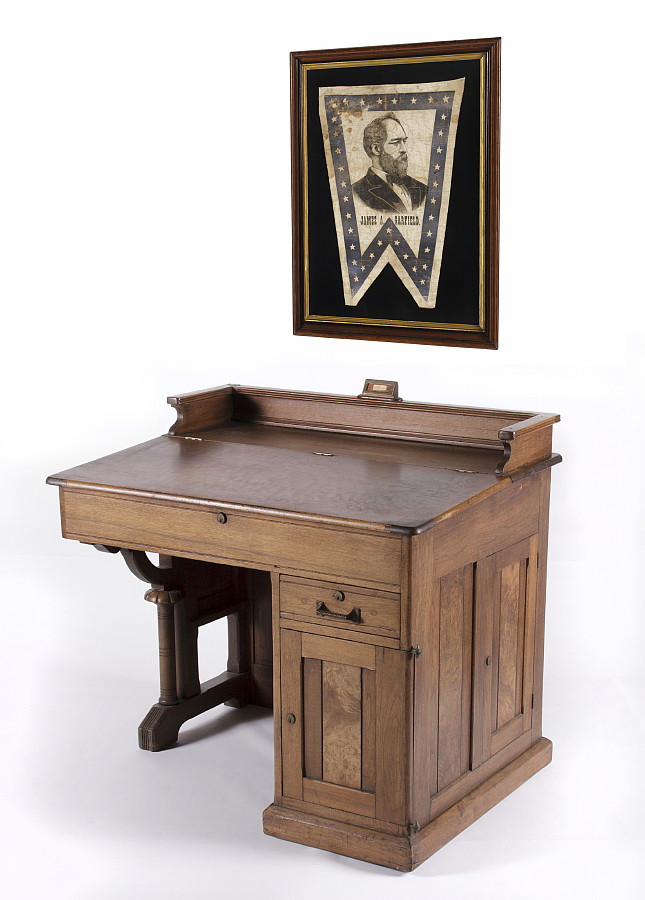
| |
THE OHIO SENATORIAL DESK OF PRESIDENT JAMES GARFIELD, 1859-1861 |
| |
|
| Dimensions (inches): |
36" tall x 39.75" wide x 29" deep |
| Description: |
|
The Ohio senatorial desk of President James Garfield, used by him between 1859 and 1861 in the chambers of the Ohio State Senate chambers. Made of solid Walnut in the early Victorian style of the period, and with figured walnut panels, the desk was installed in 1857 and removed in 1958.
The desk was acquired by John W. Bush, a member of the cabinet of Governor Frank L. Lausche (elected in 1856, served 1957-1959). Bush was head of purchasing for the State of Ohio and was in charge of refitting the chambers. In a hand-written note, penned in 1999, Bush related that "Those crazy state senators wanted new, flat-topped desks". In a typed letter, dated December 1992, Bush explained that he urged them to "let me have them refinished…but to no avail". He also stated that the senators kept their old desks, with the exception of "Charles Carney of Youngstown [who] didn't want his and gave it to me".
The desk has a brass plate with the n umber 24. Bush contacted two men at the Ohio Historical Society in Columbus, who agreed to research who had sat at it and the first definite confirmation was future president James Garfield. Others include two men who would each become the Ohio Governor, John M. Pattison (1906) and Andrew Harris (1906-1909). One of the men at the historical society published a report that accompanies the desk and details brief biographies of the three confirmed politicians. Though undated, it was clearly completed in the late 50's or early 60's.
The desk has a large and slightly slanted lift top with a flat gallery behind. The knee hole is partially open on the left with a fanciful arched support and turned leg capped with a trumpet style floral design. There is one small drawer over one door on the front and a tall door on the side. According to Bush, the side door was for a tall brass spittoon, which was originally furnished with each of the desks (not present with this one). The overall style is Eastlake. The back is attractively finished with three vertical panels so that it could be viewed all the way around on the senate floor.
Brief History of James Garfield:
James Abraham Garfield was a professor who left academics for law before his 1859 election to the Ohio State Senate. He left his seat to serve as a Union Army officer during wartime and though successful would be an accurate description of Garfield’s military career, it was brief and unlike that of his much-celebrated opponent in the 1880 presidential campaign, General Winfield Scott Hancock. Garfield left the Army in 1863 at the bidding of Abraham Lincoln and was elected to the United States Congress. His promotion to major general came after the Battle of Chickamauga, shortly before he left the Army, but after he had been elected.
In 1876 he moved from the House of Representatives to the Senate and became the Republican floor leader. In that same year he was appointed to the highly controversial Electoral Commission that put Rutherford B. Hayes in the White House despite his loss of the popular vote. In 1880 Garfield ran for president and won. Garfield and Hancock nearly tied in the popular vote, tallying 4,446,158 and 4,444,260, respectively. This represented approximately 48.3% for each candidate. Garfield won the electoral vote, however, 214 to 155. The margin between the two candidates in the popular vote remains the smallest ever in U.S. history.
Garfield served less than four months in office. He became the second U.S. president to be assassinated when he was shot by Charles J. Guiteau on July 2nd, 1881, a disgruntled man who unsuccessfully pursued a political appointment following the election. Garfield lived until September 19th, when he died as a result of his wounds. Vice President Chester Arthur succeeded to the presidency and served out the remainder of the term.
Condition: The case is entirely original. The only replacements are the locks (changed during its course of use from a kind that took skeleton keys to a modernized style), the drawer hardware, which is period Victorian (but evidently changed by the State of Ohio from a drop pull version), and the wooden shelves on the interior, behind the side door. |
|
|
| |
|
| Primary Color: |
walnut, natural |
|
| Earliest Date: |
1856 |
|
| Latest Date: |
1857 |
|
| For Sale Status: |
Sold |
|
| Price |
SOLD |
|
| E-mail: |
info@jeffbridgman.com |
|
 |
|
Page Views:... 4371 |
|


